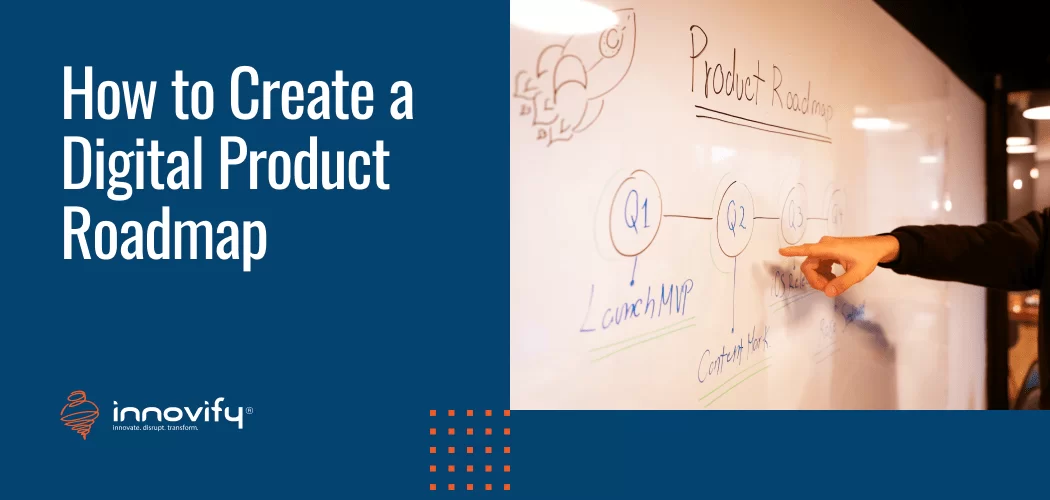AI/ML
Create digital product roadmap in 7 easy steps
How to Create a Digital Product Roadmap in 2023
It’s not just you who is struggling with creating a digital product roadmap. In fact, 32% of product managers say their most prominent product management challenge is planning & prioritizing product initiatives.
Still, creating short-term and long-term objectives and planning initiatives are critical to any website/app development process. They’re as essential for the overall product success as conducting a market analysis or developing a unique selling proposition.
Therefore, we’ve created this guide to help you with your digital product roadmap.
Let’s begin by understanding what a Digital Product Roadmap is?
What is a Digital Product Roadmap?
A digital product roadmap is a document that describes the vision, direction, priorities, and progress of a product.
It is possible to create digital product roadmaps using a variety of software tools. You may find a list of digital product roadmap tools at the end of the article.
Product Roadmaps are used for projects of any scale, ranging from four weeks to two years and more. Although a roadmap is not set in stone, it may be used to request and insert new features or requirements or respond to customer demands.
In a broader outlook, a product roadmap is a part of the overall strategy, which look something like this:
- Product Vision: What does the world look like when your product is in use?
- Product Mission: What are you trying to achieve?
- Goals: The objectives you’ll have to accomplish in order to get to your vision.
- Product Strategy: How will you achieve your goals?
- Product Roadmap: What do you need to build to get to your vision?
- Tasks: What do you have to do today to keep the momentum going?
A product roadmap can help software teams identify customer issues (i.e., goals) that align with their overall strategy and then decide which features and bug fixes to focus on.
Want to create a strong digital product roadmap that leads to successful product
Get in touch with us nowWhat’s the Purpose of Digital Product Roadmaps?
The most critical use case of digital product roadmaps is “communication tool.” Digital product roadmaps offer the following benefits as well:
- Backing up your vision and strategy
- Creating an action plan to bring your strategy to life
- Get stakeholders’ buy-in and team alignment
- Making space for scenario planning and discussion
- Building excitement and boosting motivation
A project or company comprises hundreds (or thousands!) of moving parts, and therefore a roadmap is essential for bringing clarity and focus. A roadmap specifies exactly what to do next and why it matters rather than a long list of tasks or an unorganized backlog.
Types of Product Roadmaps
The product roadmap can be in the following three forms:
Timeline-Based Roadmaps
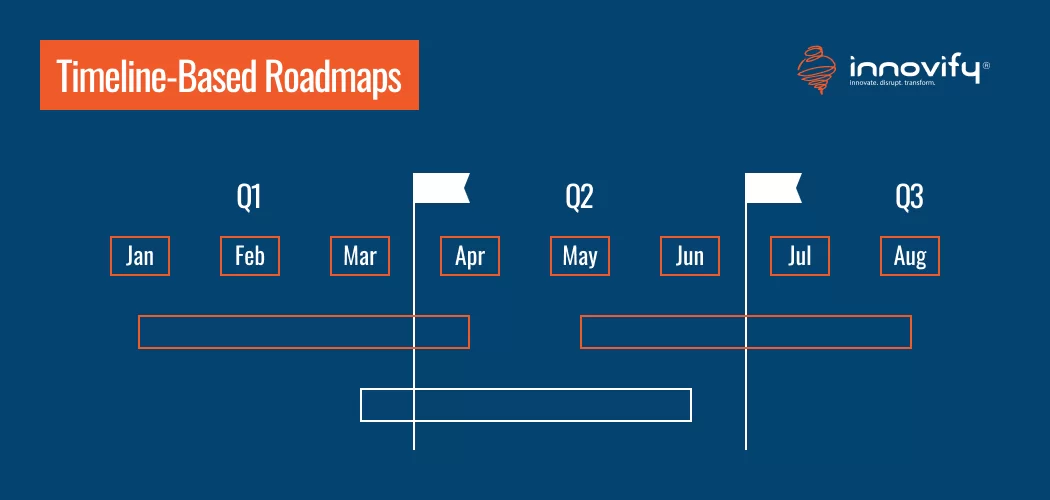
Project phases are organized according to the time they take. Stakeholders can see what you’re currently working on. For you, it’s an opportunity to explain why the team can’t work faster or shift deadlines.
No-Dates Roadmaps
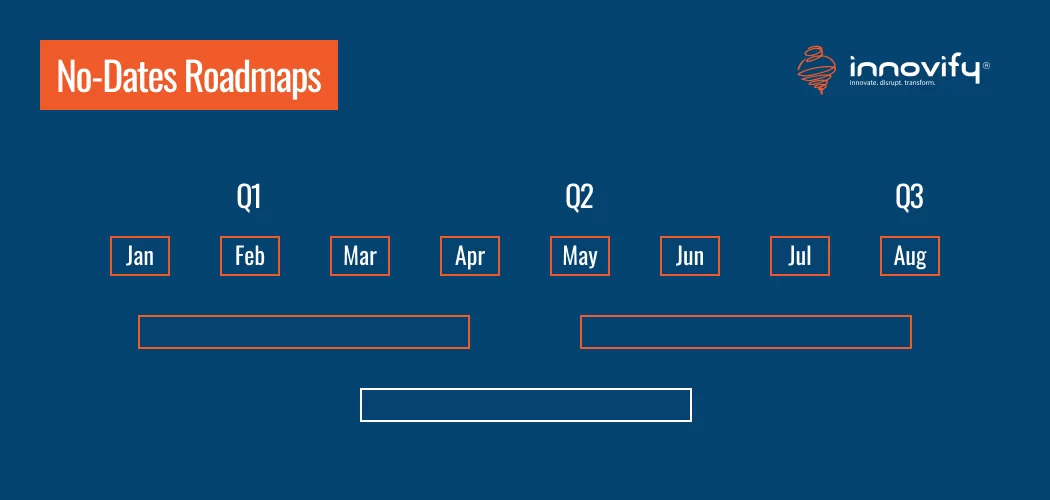
When creating a product roadmap report for marketing or sales groups or other departments, businesses opt for date-free documents. Their objective is to generate interest and set expectations for clients, communicate the message and benefits to sales reps, and express the product vision—to top management. However, in the digital product case, this type isn’t applicable.
Kanban Roadmaps
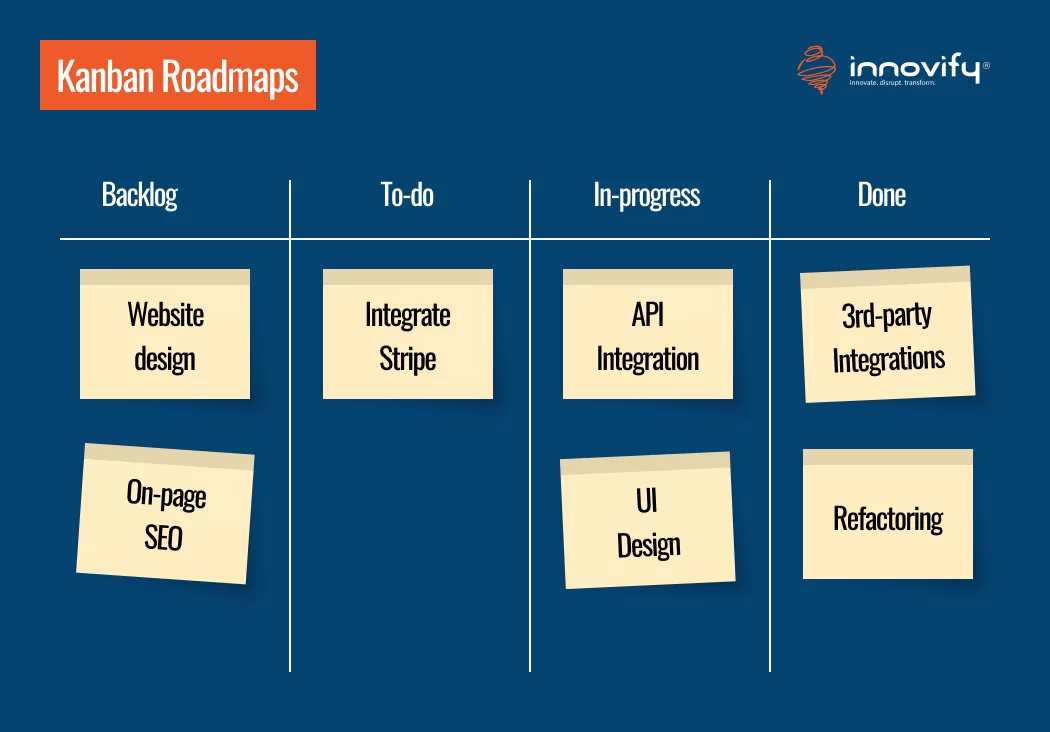
A Kanban blueprint displays the current initiatives while focusing on product strategy. These blueprints are terrific for digital product development teams since they display the status and priorities of every task and activity.
Digital Product Roadmap Differ for Agile and Waterfall Teams
A product road map, however, will have different levels of detail depending on the software development process you use.
For instance, for traditional development teams (aka waterfall teams), a roadmap is the product planning grail. Every step leading up to the launch must be carefully planned and organized before you begin building. A roadmap helps you work efficiently and determines what must be done and in what order.
And, what about Agile teams?
Agile product roadmaps are outcome-based. This means that Instead of striving for a specific feature or item, Agile roadmaps focus on the goals.
Agile roadmaps describe your business goals in a way that helps you alter user behavior in a way that ultimately benefits you. Of course, your ultimate goal is somewhat hazy, but you are heading in a specific direction and have enough information to power at least your team’s next few sprints with an Agile roadmap.
Here is an outcome-based project roadmap example:
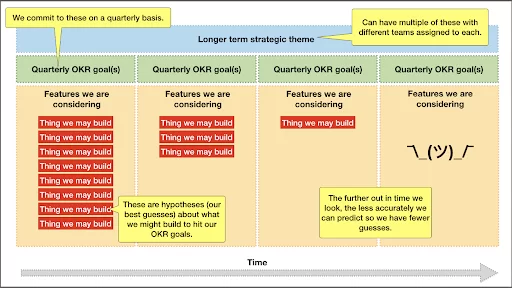
Source: Jeff Gothelf
Lets build your winning roadmap!
Contact us to get started7 Steps to Create Digital Product Roadmap
Here is how you can build a digital product roadmap from ground zero:
1. Market Research and Context Building
The purpose of your solution should be to solve the problems of your potential customer. You can start by conducting a competitive and market analysis. You will not be able to create a sensible strategy if you do not know the purpose and ultimate objective of your solution.
The market research should include:
- Current market state of product niche
- Existing players in the market
- Customer research
- Most favored pricing plans by the customers, etc.Most favored pricing plans by the customers, etc.
2. Decide on the Outcome
Development teams use product roadmaps to help them plan. They focus on the outcome they wish to achieve in order to further their overall strategy.
Your roadmap should start with business requirements. Products or features are just a means to an end. To put it differently, ask yourself what impact your roadmap would have on your business and why it is important.
Look at your strategy and vision to find areas of improvement, or examine your research on the market, competitors, internal requests from stakeholders, external requests from customers, or even existing tasks in your backlog.
3. Prioritize Product Features and Attributes
Your product may or may not possess all the features in the beginning. Hence, you should classify attributes according to their importance and complexity. Define the scope of features for future releases, version schedules, and updates, as well as real deadlines.
Here are some tips:
- You can begin with a theme-based road map to present a bird’s eye view of your priorities and then create more detailed blueprints
- You can organize and plan activities using the impact mapping technique to help your team achieve the product goal
- Visualize the overall scope of the product using the product tree technique
- When reassessing or re-prioritizing features, take into account tech aspects, finance, or regulation-related dependencies and risks
4. Set a Timeframe
Of course, your desired outcome and what problems you’ve identified are the starting point. Is there anything you can test in the coming months that would solve these issues? Or are you planning on pursuing major strategic shifts that might take years to finish?
Irrespective of your objectives, remember that transformation requires time. A roadmap, on the other hand, should emphasize progress early on to prevent you from blindly pursuing results for years.
5. Couple Your Roadmap with the Right Set of Metrics
It’s crucial to include some genuine figures in your document to make it more persuasive. However, don’t include all information related to your product’s future because some numbers might be overwhelming and mislead the audience.
For instance, when reviewing your roadmaps, start with concrete goals and KPIs. Industry experts and market analysis are the best approaches to deciding on the key metrics for your digital product. Also, make sure that your metrics correspond with the product goal.
In short, all measurements can be divided into a customer- and business-oriented metrics. Here are some examples of data you may find relevant to include in your product plan.
- Growth projection in the number of users
- Market share projection
- Expected number of users per phase
6. Migrate Your Roadmap on a Tool
Now you have everything you need to build your product roadmap and get your decision-makers’ buy-in. Let’s take it a step further. If everyone has access to it, roadmaps build trust between you and your development team.
For this, you need a central hub for your product roadmap, strategy, and velocity sprints. Everything is connected and accessible using a project management tool.
For example, using a project management tool, you may create a simple Kanban board to show what work is being done and how it connects to your overall roadmap.
But what tools can you use for the project roadmap?
Following are the best ones:
- Prodpad
- Roadmunk
- Product Plan
- Casual
- Roadmap.space
Product roadmaps require deep analysis, consideration, and compromise. Assuming that you aren’t a one-person operation, you must consider the needs of the rest of your organization.
You can collaborate with other teams and stakeholders early in the process to gather their views on the roadmap.
You may ask the following questions:
- Do you feel that we can reshuffle the priorities? If yes, can you elaborate?
- The industry is growing at a rapid pace, and there can be a threat of new entrants. How can we improve our product strategy to counter that?
- Are there any techniques we can use to speed up the project delivery?
Once you’ve accommodated the changes suggested, you’re good to go.
Keep Your Roadmap Flexible
A product roadmap must be flexible with eyes on the future but feet firmly rooted in the present. Start with a business need, identify issues to solve, and then create a clear and executable product roadmap, and your whole corporation will have the guidance they need to move in the direction of your goals.

